The Montellina Spring as an Example of Water Circulation in an Alpine DSGSD Context (NW Italy)
Abstract
1. Introduction
2. Location and Features of the Montellina Spring
3. Methodology
3.1. Geological Survey
3.2. Hydrogeological Survey
3.2.1. Water Sampling and Analyses
3.2.2. Hydrologic Balance of the Renanchio Basin
3.2.3. Tracer Tests for Streamflow Discharge and GW-SW Interactions Assessment
NaCl Tracer Tests
Fluorescein Tracer Tests
4. Results
4.1. Results of the Geological Survey
4.1.1. Bedrock
4.1.2. Quaternary Succession
4.1.3. DSGSD Morpho-Structures
4.2. Hydrogeological Survey
4.2.1. Physical-Chemical Analyses
4.2.2. Hydrologic Balance
4.2.3. Results of Tracer Tests
NaCl Tracer Tests
Fluorescein Tracer Tests
5. Discussion
6. Conclusion
Author Contributions
Conflicts of Interest
References
- De Luca, D.A.; Masciocco, L.; Caviglia, C.; Destefanis, E.; Forno, M.G.; Fratianni, S.; Gattiglio, M.; Lasagna, M.; Gianotti, F.; Latagliata, V.; et al. Distribution, discharge, geological and physical-chemical features of the springs in the Turin Province (Piedmont, NW Italy). In Engineering Geology for Society and Territory; Springer: Berlin/Heldelberg, Germany, 2015; Volume 3, pp. 253–256. [Google Scholar] [CrossRef]
- Banzato, C.; Governa, M.; Petricig, M.; Vigna, B. The importance of monitoring for the determination of aquifer vulnerability and spring protection areas. In Engineering Geology for Society and Territory; Springer: Berlin/Heldelberg, Germany, 2015; Volume 5, pp. 1379–1385. [Google Scholar]
- Binet, S.; Spadini, L.; Bertrand, C.; Guglielmi, Y.; Mudry, J.; Scavia, C. Variability of the groundwater sulfate concentration in fractured rock slopes: A tool to identify active unstable areas. Hydrol. Earth Sys. Sci. Discuss. 2009, 13, 2315–2327. [Google Scholar] [CrossRef]
- Ostermann, M.; Koltai, G.; Spötl, C.; Cheng, H. Deep-seated gravitational slope deformations in the Vinschgau (northern Italy) and their association with springs and speleothems. In Proceedings of the EGU General Assembly Conference Abstracts, Vienna, Austria, 17–22 April 2016. [Google Scholar]
- Forno, M.G.; Comina, C.; Gattiglio, M.; Gianotti, F.; Lo Russo, S.; Sambuelli, L.; Raiteri, L.; Taddia, G. Preservation of Quaternary sediments in DSGSD environment: The Mont Fallére case study (Aosta Valley, NW Italy). Alp. Mediterr. Quat. 2016, 29, 1–11. [Google Scholar]
- Madritsch, H.; Millen, B.M.J. Hydrogeologic evidence for a continuous basal shear zone within a deep-seated gravitational slope deformation (Eastern Alps, Tyrol, Austria). Landslides 2007, 4, 149–162. [Google Scholar] [CrossRef]
- Pergher, L.; Burger, U. Measurement of the physical properties of spring water—An easy an efficient tool for the process analysis of mass movements. In Proceedings of the 10th Interpraevent Congress, Riva del Garda, Italy, 24–27 May 2005. [Google Scholar]
- Compagnoni, R.; Dal Piaz, G.V.; Hunziker, J.C.; Lombardo, B.; Williams, P.F. The Sesia-Lanzo Zone, a slice of continental crust with alpine high pressure-low temperature assemblages in the Western Italian Alps. Rend. Soc. It. Mineral. Petrog. 1977, 33, 281–334. [Google Scholar]
- Regis, D.; Venturini, G.; Engi, M. Geology of the Scalaro Valley-Sesia Zone (Italian Western Alps). J. Maps 2016, 12, 621–629. [Google Scholar] [CrossRef]
- Venturini, G. Geology, geochemistry and geochronology of the inner central Sesia Zone (Western Alps, Italy). Mém. Géol. Lausanne 1995, 25, 1–148. [Google Scholar]
- Rocco, R.; Santelli, E. Water Resources Management in Valle d’Aosta (Northwest of Italy). AQUA Mundi 2010, Am01013, 93–100. [Google Scholar] [CrossRef]
- Stefania, G.A.; Rotiroti, M.; Fumagalli, L.; Zanotti, C.; Bonomi, T. Numerical Modeling of Remediation Scenarios of a Groundwater Cr(VI) Plume in an Alpine Valley Aquifer. Geosciences 2018, 8, 209. [Google Scholar] [CrossRef]
- De Luca, D.A.; Destefanis, E.; Forno, M.G.; Lasagna, M.; Masciocco, L. The genesis and the hydrogeological features of the Turin Po Plain fontanili, typical lowland springs in Northern Italy. Bull. Eng. Geol. Environ. 2014, 73, 409–427. [Google Scholar] [CrossRef]
- De Luca, D.A.; Dell’Orto, V.; Destefanis, E.; Forno, M.G.; Lasagna, M.; Masciocco, L. Hydrogeological structure of the “fontanili” in Turin Plain. Rend. Onl. Soc. Geol. It. 2009, 6, 199–200. [Google Scholar]
- Perello, P. Derivazione a Scopi Idroelettrici del Torrente Renanchio. Studio Idrogeologico per la Sorgente Montellina; SEA Consulting srl & GDP. 2010; Unpublished work. [Google Scholar]
- Di Gioia, M. Studio Idrogeologico circa i Rapporti tra il Torrente Renanchio e la Sorgente Montellina. 2012; Unpublished report. [Google Scholar]
- Piper, A.M. A graphic procedure in the chemical interpretation of water analysis. Am. Geophys. Un. Trans. 1944, 25, 914–923. [Google Scholar] [CrossRef]
- Turc, L. Water requirements assessment of irrigation, potential evapotranspiration: Simplified and updated climatic formula. Ann. Agron. 1961, 12, 13–49. [Google Scholar]
- Celico, P. Prospezioni Idrogeologiche II; Liguori Editore: Napoli, Italy, 1988. [Google Scholar]
- Kalbus, E.; Reinstorf, F.; Schirmer, M. Measuring methods for groundwater-surface water interactions: A review. Hydrol. Earth Syst. Sci. 2006, 10, 873–887. [Google Scholar] [CrossRef]
- Carter, R.W.; Davidian, J. General procedures for gaging streams. In Techniques of Water Resources Investigations; US Geological Survey: Denver, CO, USA, 2009; Book 3, Chapter A-14. [Google Scholar]
- Kilpatrick, F.A.; Schneider, V.R. Use of flumes in measuring discharge. In Techniques of Water-Resources Investigations; US Geological Survey: Denver, CO, USA, 1983. [Google Scholar]
- Rantz, S.E. Measurement and Computation of Streamflow: Volume 1. Measurement of Stage and Discharge; US Geological Survey Water-Supply Paper; US Department of the Interior, US Government Printing Office: Washington, DC, USA, 1982; Volume 2175.
- Kilpatrick, F.A.; Cobb, E.D. Measurement of discharge using tracers. In Techniques of Water-Resources Investigations; US Geological Survey: Denver, CO, USA, 1985; Book 3, Chapter A-16. [Google Scholar]
- Moore, R.D. Introduction to salt dilution gauging for streamflow measurement: Part I. Streaml. Water. Manage. Bull. 2004, 7, 20–23. [Google Scholar]
- Radulović, M.; Radojević, D.; Dević, D.; Blečić, M. Discharge calculation of the spring using salt dilution method. Application site Bolje Sestre Spring (Montenegro). In Proceedings of the BALWOIS 2008, Ohrid, Republic of Macedonia, 27–31 May 2008. [Google Scholar]
- Moore, R.D. Slug injection using salt in solution. Streaml. Water. Manag. Bull. 2005, 8, 1–6. [Google Scholar]
- Wood, P.J.; Dykes, A.P. The use of salt dilution gauging techniques: Ecological considerations and insights. Wat. Res. 2002, 36, 3054–3062. [Google Scholar] [CrossRef]
- Drost, J.W. Single-well and multi-well nuclear tracer techniques-a critical review. In Technical Documents in Hydrology; UNESCO: Paris, France, 1989. [Google Scholar]
- Zellweger, G.W. Testing and comparison of four ionic tracers to measure stream flow loss by multiple tracer injection. Hydrol. Process. 1994, 8, 155–165. [Google Scholar] [CrossRef]
- Kumar, B.; Nachiappan, R.P. Estimation of alluvial aquifer parameters by a single-well dilution technique using isotopic and chemical tracers: A comparison. In Tracers and Modelling in Hydrogeology; Dassargues, A., Ed.; IAHS Press, IAHS Publ.: Wallingford, UK, 2000; Volume 262, pp. 53–56. [Google Scholar]
- Tazioli, A. Experimental methods for river discharge measurements: Comparison among tracers and current meter. Hydrol. Sci. J. 2011, 56, 1314–1324. [Google Scholar] [CrossRef]
- Comina, C.; Lasagna, M.; De Luca, D.A.; Sambuelli, L. Geophysical methods to support correct water sampling locations for salt dilution gauging. Hydrol. Earth Syst. Sci. 2014, 18, 3195–3203. [Google Scholar] [CrossRef]
- Gees, A. Flow measurement under difficult measuring conditions: Field experience with the salt dilution method. In Hydrology in Mountainous Regions; IAHS Publication: Wallinford, UK, 1990; Volume 193, pp. 255–262. [Google Scholar]
- Käss, W. Tracing Technique in Geohydrology; Balkema: Rotterdam, The Netherlands, 1998. [Google Scholar]
- Taylor, C.J.; Greene, E.A. Hydrogeologic characterization and methods used in the investigation of karst hydrology. In Field Techniques for Estimating Water Fluxes between Surface Water and Ground Water; Rosenberry, D.O., La Baugh, J.W., Eds.; US Geological Survey: Denver, CO, USA, 2008. [Google Scholar]
- Clemente, P.; Lasagna, M.; Dino, G.A.; De Luca, D.A. Comparison of different methods for detecting irrigation canals leakage. In Engineering Geology for Society and Territory; Lollino, G., Arattano, M., Rinaldi, M., Giustolisi, O., Marechal, J.C., Grant, G.E., Eds.; Springer: Berlin/Heldelberg, Germany, 2015; Volume 3, pp. 23–26. [Google Scholar] [CrossRef]
- Aldous, P.J.; Fawell, J.K. The Use of Fluorescein Sodium (Uranine) for Groundwater Tracing Investigations in Potable Water Supplies; WRc Environment, Medmenham Lab.: Medmenham Bucks, UK, 1986. [Google Scholar]
- Field, M.S.; Wilhelm, R.G.; Quinlan, J.F.; Aley, T.J. An assessment of the potential adverse properties of fluorescent tracer dyes used for groundwater tracing. Environ. Monit. Ass. 1995, 38, 75–96. [Google Scholar] [CrossRef]
- Behrens, H.; Beims, U.; Dieter, H.; Dietze, G.; Eikmann, T.; Grummt, T.; Hanisch, H.; Henseling, H.; Kaess, W.; Kerndorff, H.; et al. Toxicological and ecotoxicological assessment of water tracers. Hydrogeol. J. 2001, 9, 321–325. [Google Scholar] [CrossRef]
- Hart, S.R.; Staudigel, H.; Workman, R.; Koppers, A.A.P.; Girard, A.P. A fluorescein tracer release experiment in the hydrothermally active crater of Vailulu’u volcano, Samoa. J. Geophys. Res. 2003, 108, 2377. [Google Scholar] [CrossRef]
- Buzády, A.; Erostyák, J.; Paàl, G. Determination of uranine tracer dye from underground water of Mecsek Hill, Hungary. J. Biochem. Biophys. Meth. 2009, 69, 207–214. [Google Scholar] [CrossRef]
- Rowinski, P.M.; Chrzanowski, M. Influence of selected fluorescent dyes on small aquatic organisms. Act. Geophys. 2010, 59, 91–109. [Google Scholar] [CrossRef]
- Kasnavia, T.; Vu, D.; Sabatini, D.A. Fluorescent dye and media properties affecting sorption and tracer selection. Groundwater 1999, 37, 376–381. [Google Scholar] [CrossRef]
- Smart, C.C.; Zabo, L.; Alexander, E.C., Jr.; Worthington, S.R.H. Some advances in fluorometric techniques for water tracing. Environ. Monit. Assess. 1998, 53, 305–320. [Google Scholar] [CrossRef]
- Field, M.S. Quantitative analysis of tracer breakthrough curves from tracing tests in karst aquifers. In Karst Modelling; Palmer, A.N., Palmer, M.V., Sasowsky, I.D., Eds.; Karst Waters Institute Special Publication: Leesburg, VA, USA, 1999; Volume 5, pp. 163–171. [Google Scholar]
- Mull, D.S.; Smoot, J.L.; Liebermann, T.D. Dye tracing techniques used to determine ground-water flow in a carbonate aquifer system near Elizabethtown, Kentucky. In Water-Resources Investigations Report; US Geological Survey: Denver, CO, USA, 1988; pp. 1–95. [Google Scholar]
- Gospodaric, R.; Habic, P. Underground water tracing-Investigations in Slovenia, 1972–1975; Postojna Inst. for Karts Research SAZU: Postojna, Yugoslavia, 1976; pp. 1–305. [Google Scholar]
- Wright, W.G.; Moore, B. Application of Tracer-Injection Techniques to Demonstrate Surface-Water and Ground-Water Interactions between an Alpine Stream and the North Star Mine, Upper Animas River Watershed, Southwestern Colorado; U.S. Department of the Interior, U.S. Geological Survey: Reston, VA, USA, 2003.
- Schnegg, P.A. An inexpensive field fluorometer for hydrogeological tracer tests with three tracers and turbidity measurement. In Proceedings of the 22th IAH and ALHSUD Congress on Groundwater and Human Development, Mar del Plata, Argentina, 21–25 October 2002; Bocanegra, E., Martinez, D., Massone, H., Eds.; pp. 1484–1488. [Google Scholar]
- Schnegg, P.A. A new field fluorometer for multi-tracer tests and turbidity measurement applied to hydro-geological problems. In Proceedings of the 8th International Congress of the Brazilian Geophysical Society, Rio de Janeiro, Brazil, 14–18 September 2003. [Google Scholar]
- Poulain, A.; Rochez, G.; Van Roy, J.P.; Dewaide, L.; Hallet, V.; De Sadelaer, G. A compact field fluorometer and its application to dye tracing in karst environments. Hydrogeol. J. 2017, 25, 1517–1524. [Google Scholar] [CrossRef]
- Field, M.S. The QTRACER2 Program for Tracer-Breakthrough Curve Analysis for Tracer Tests in Karstic Aquifers and Other Hydrologic Systems; US Environmental Protection Agency: Washington, DC, USA, 2002; pp. 1–179.
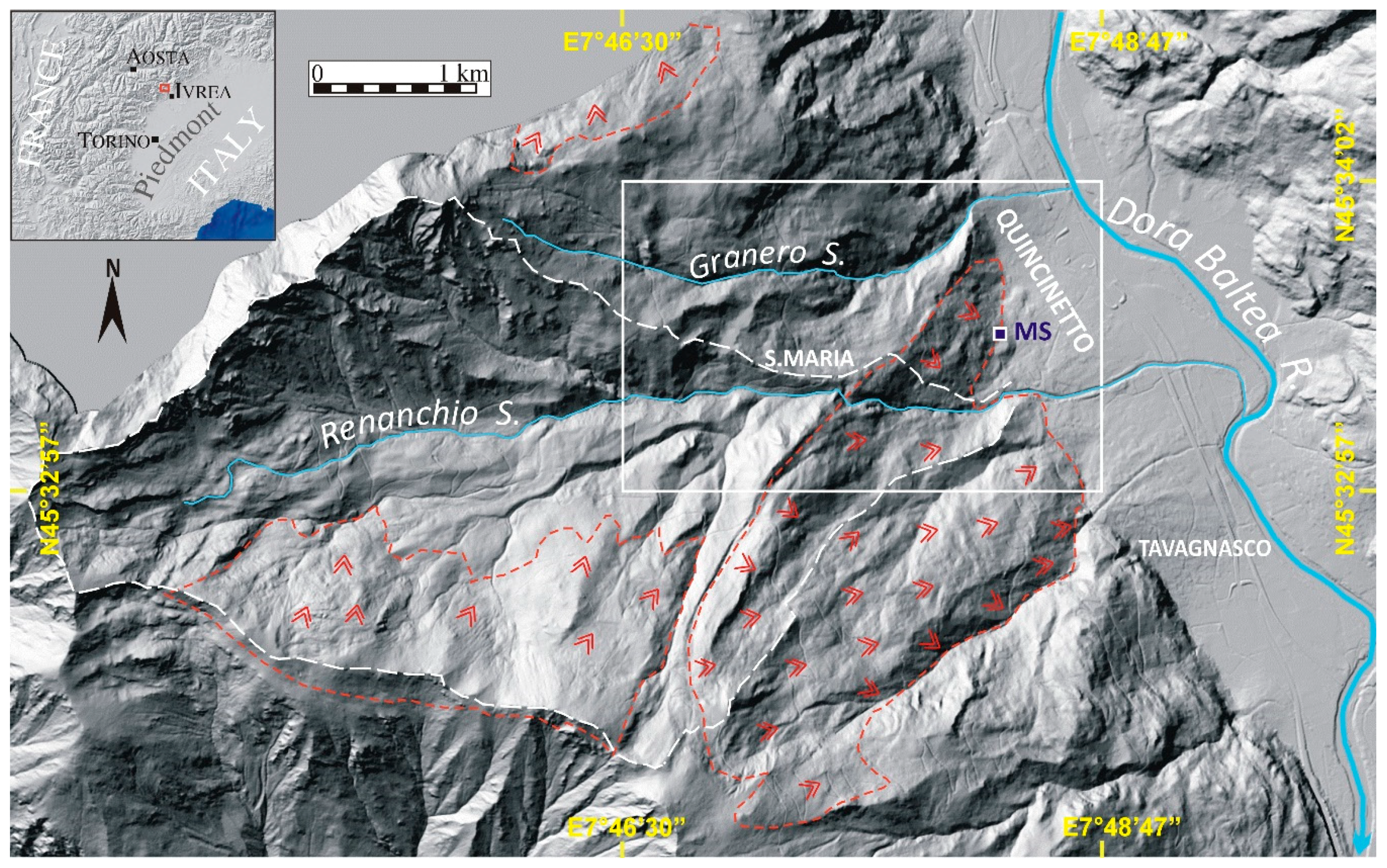
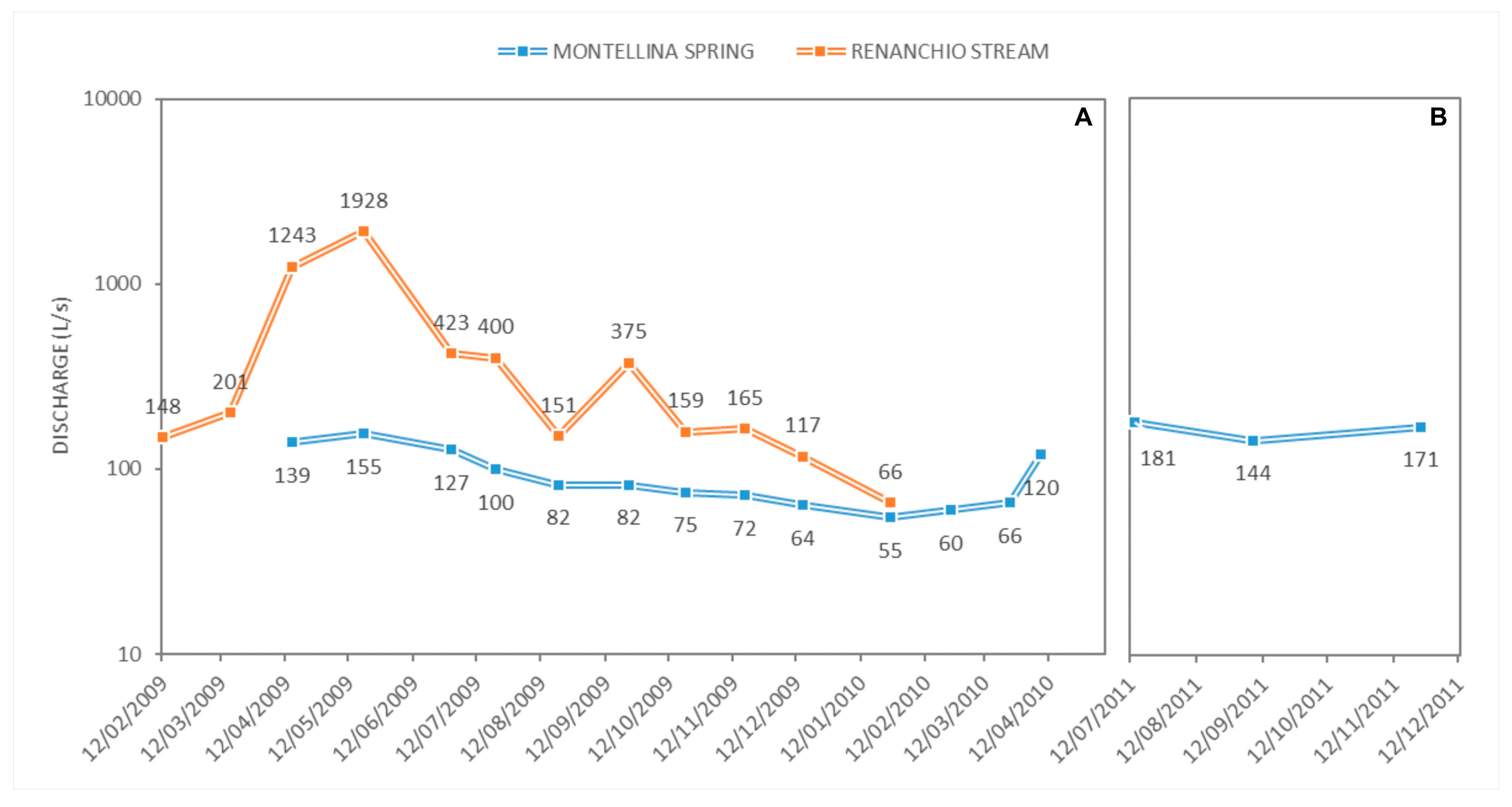
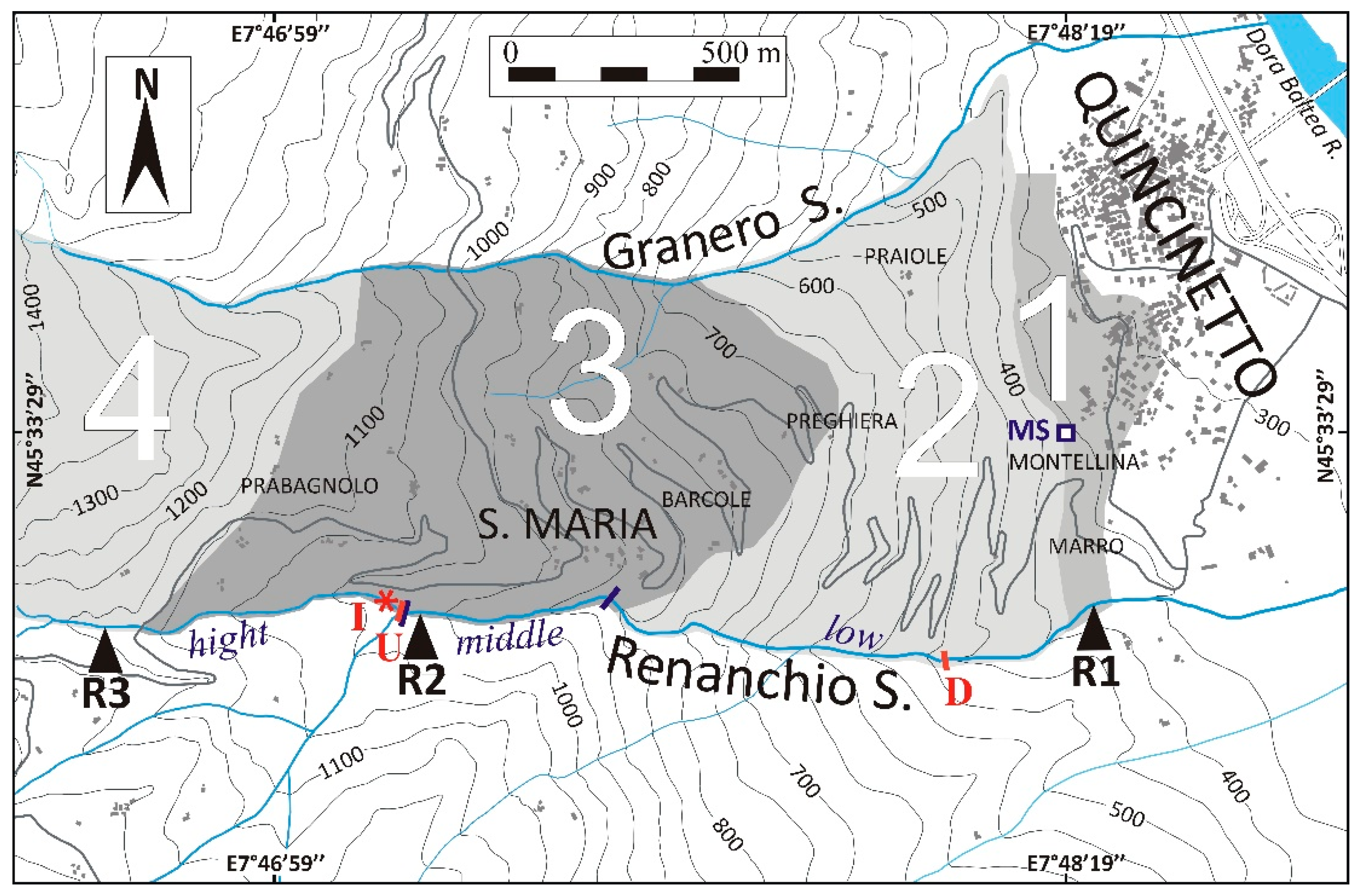
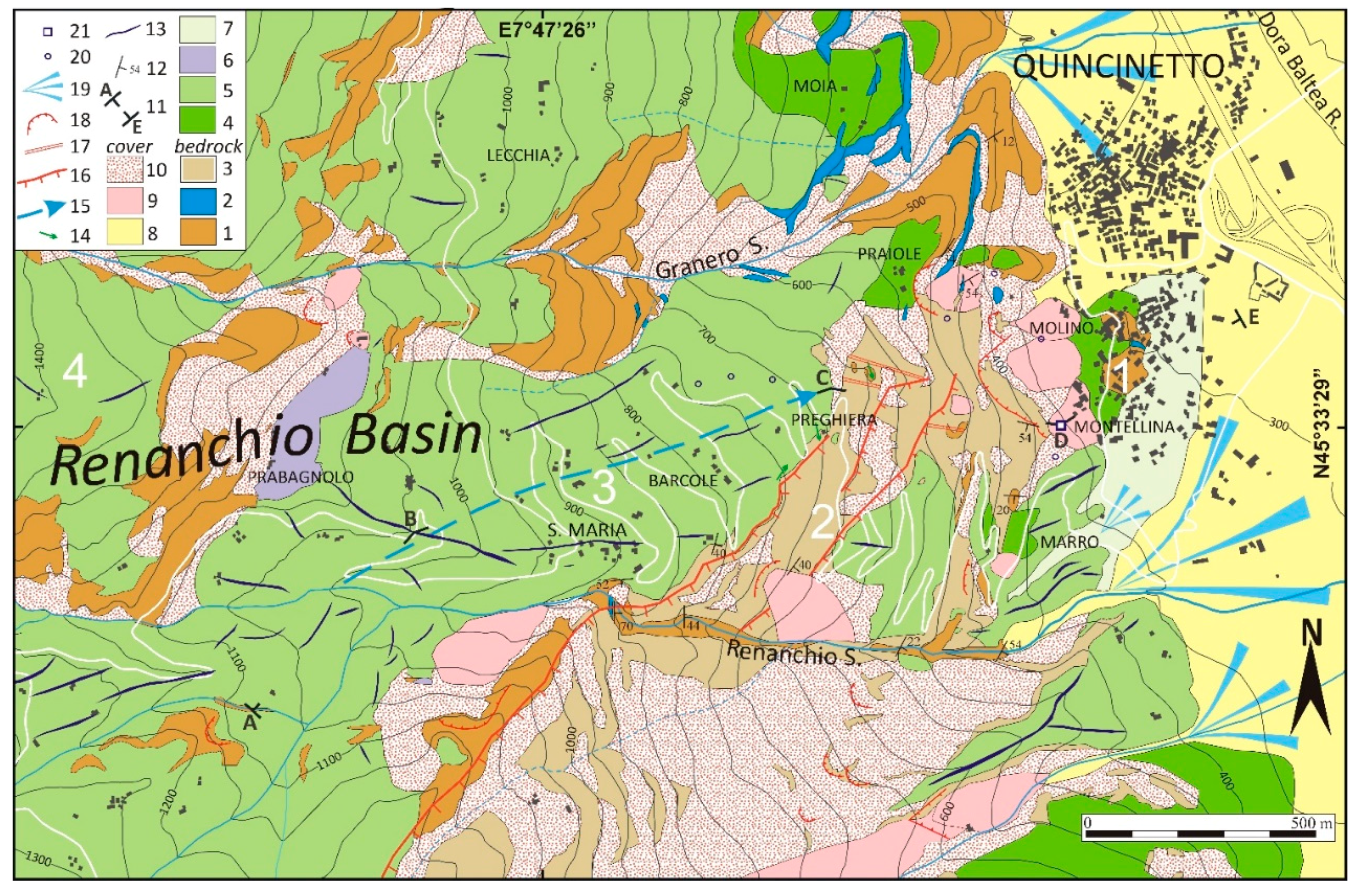
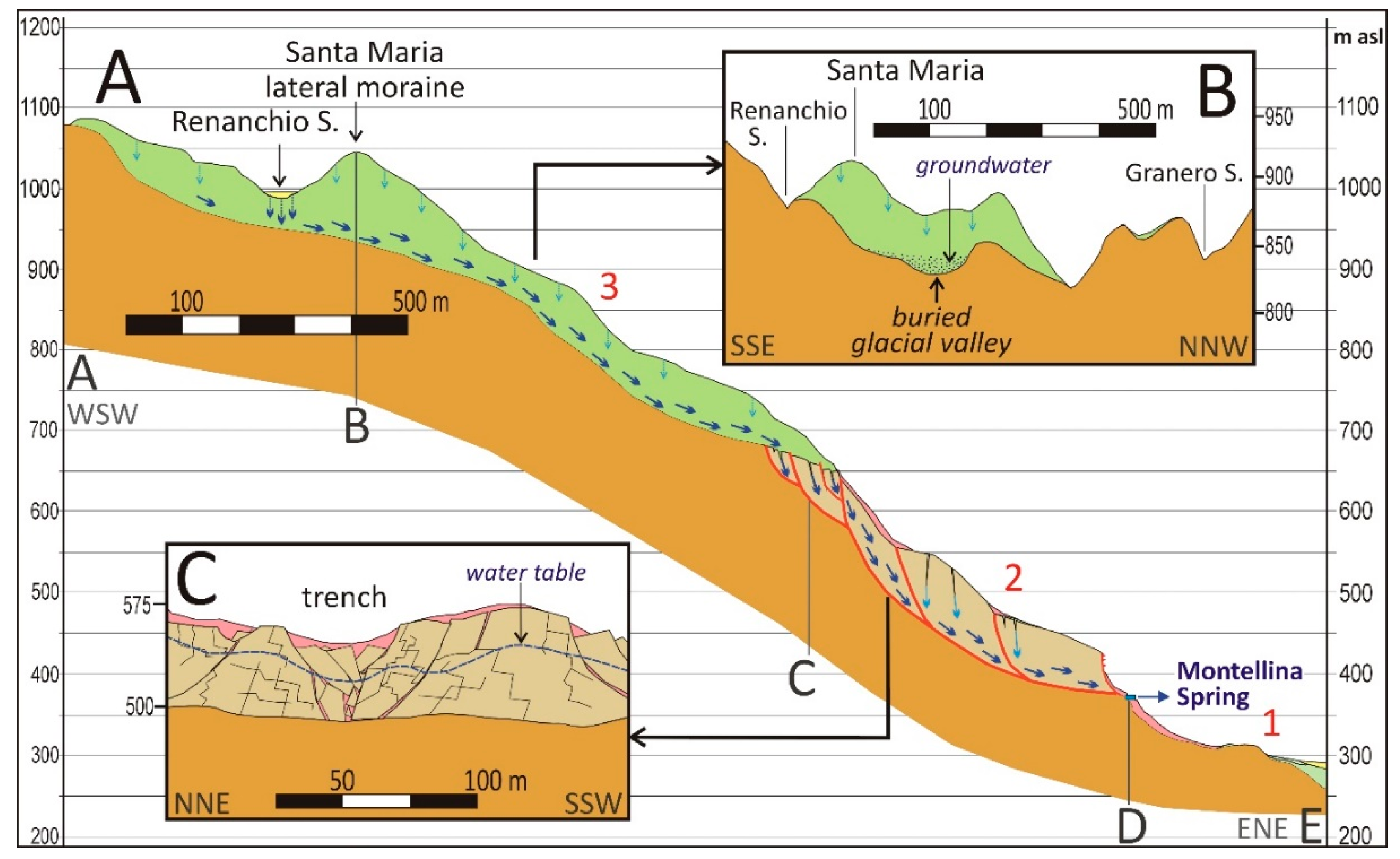
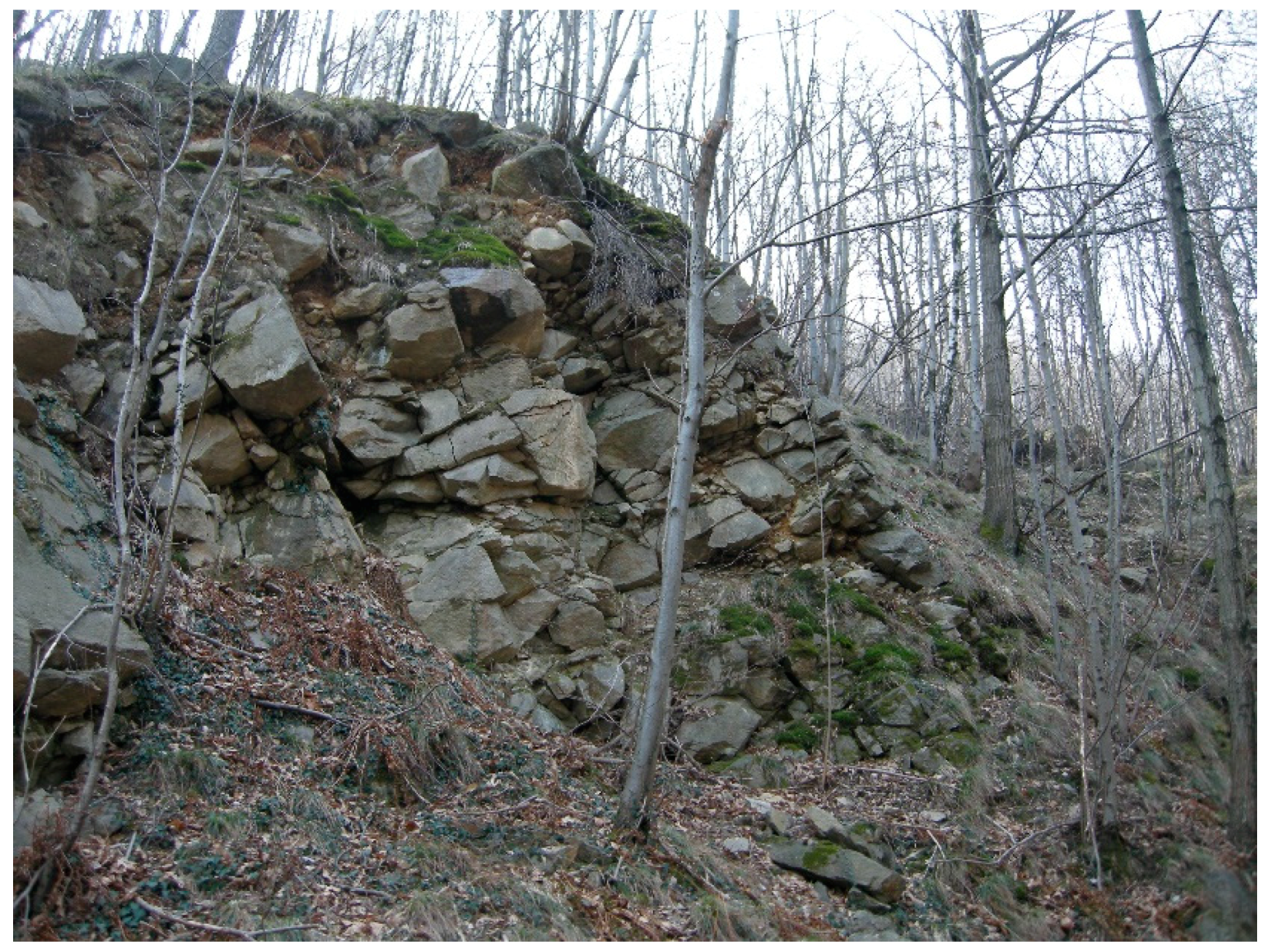
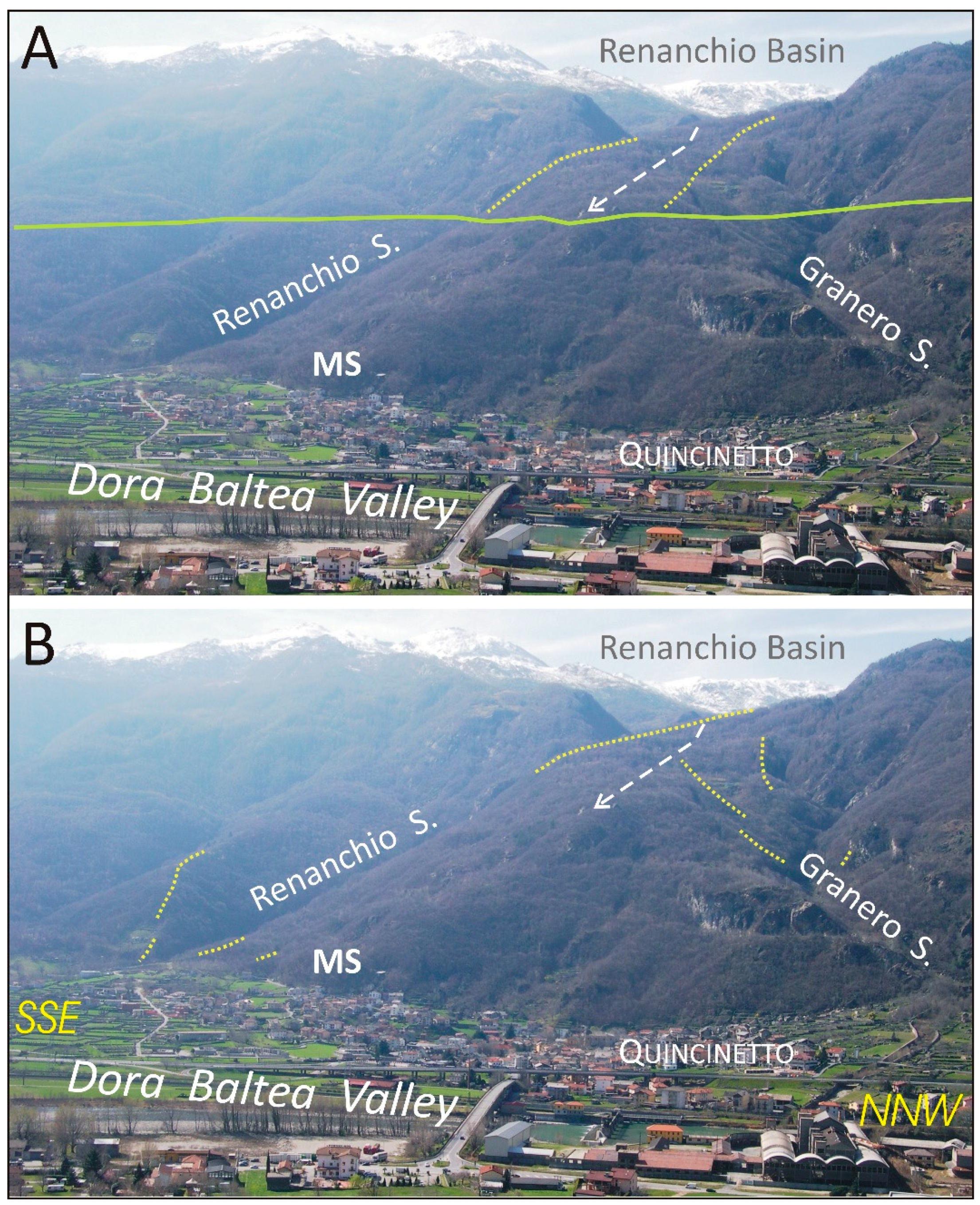
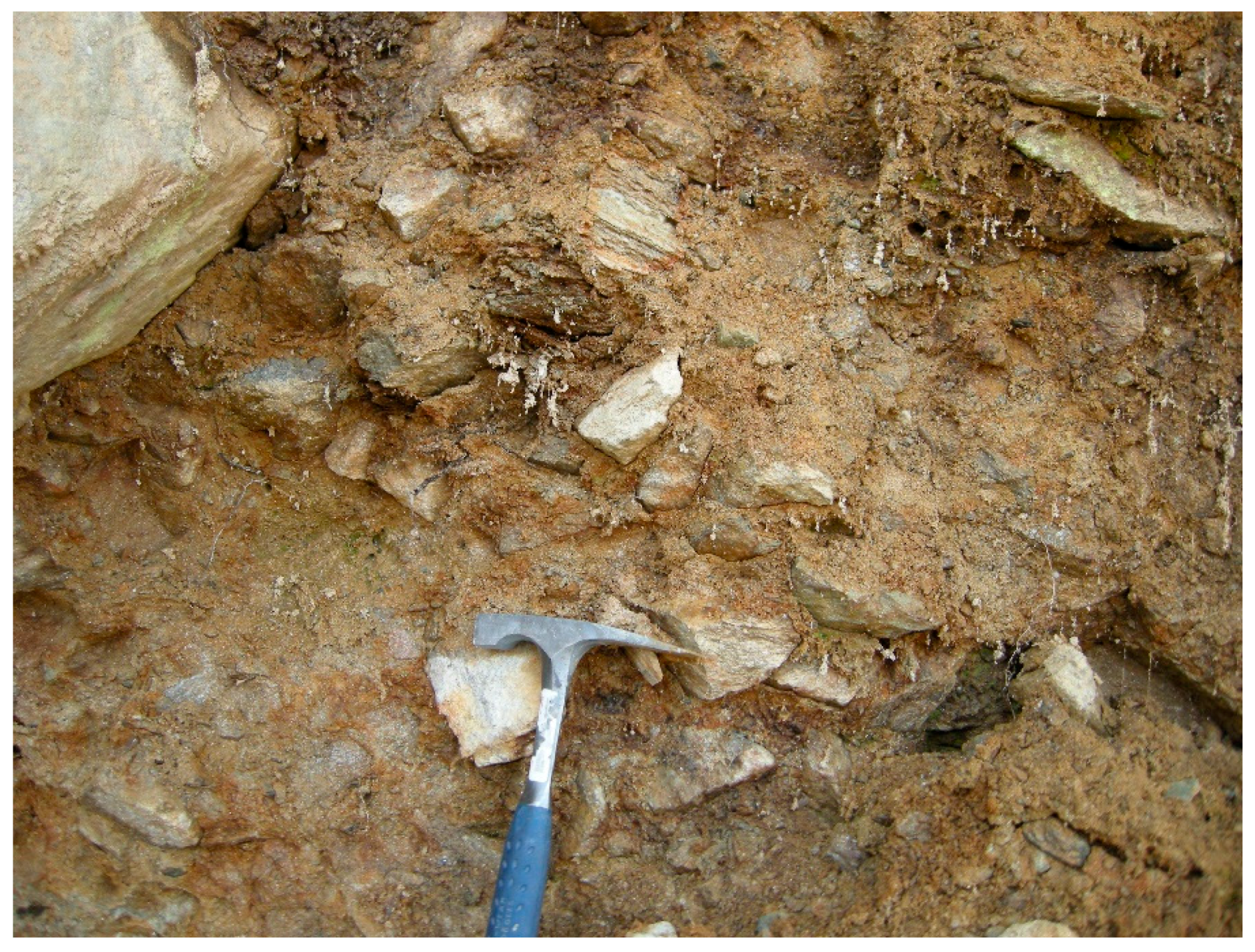
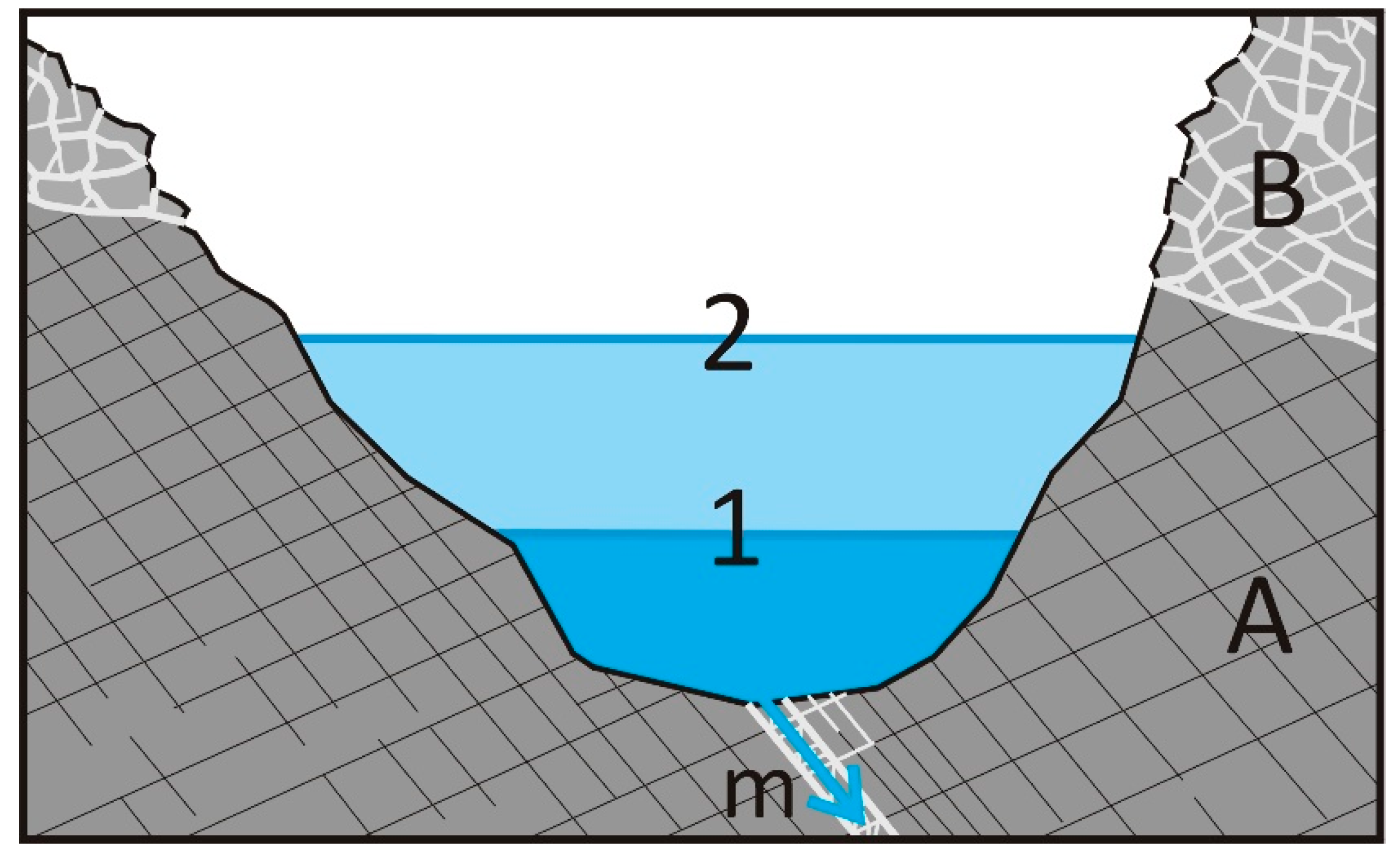

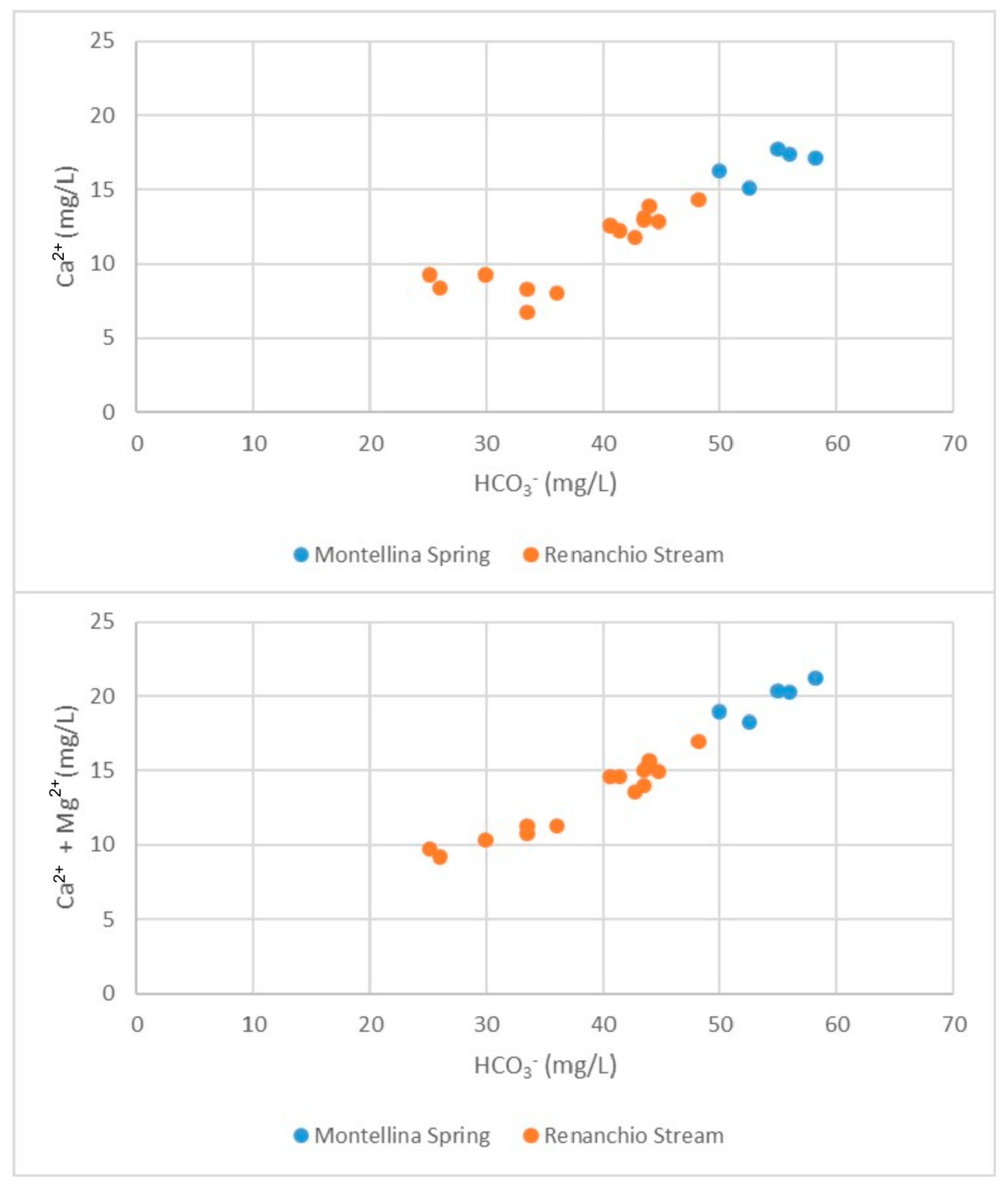
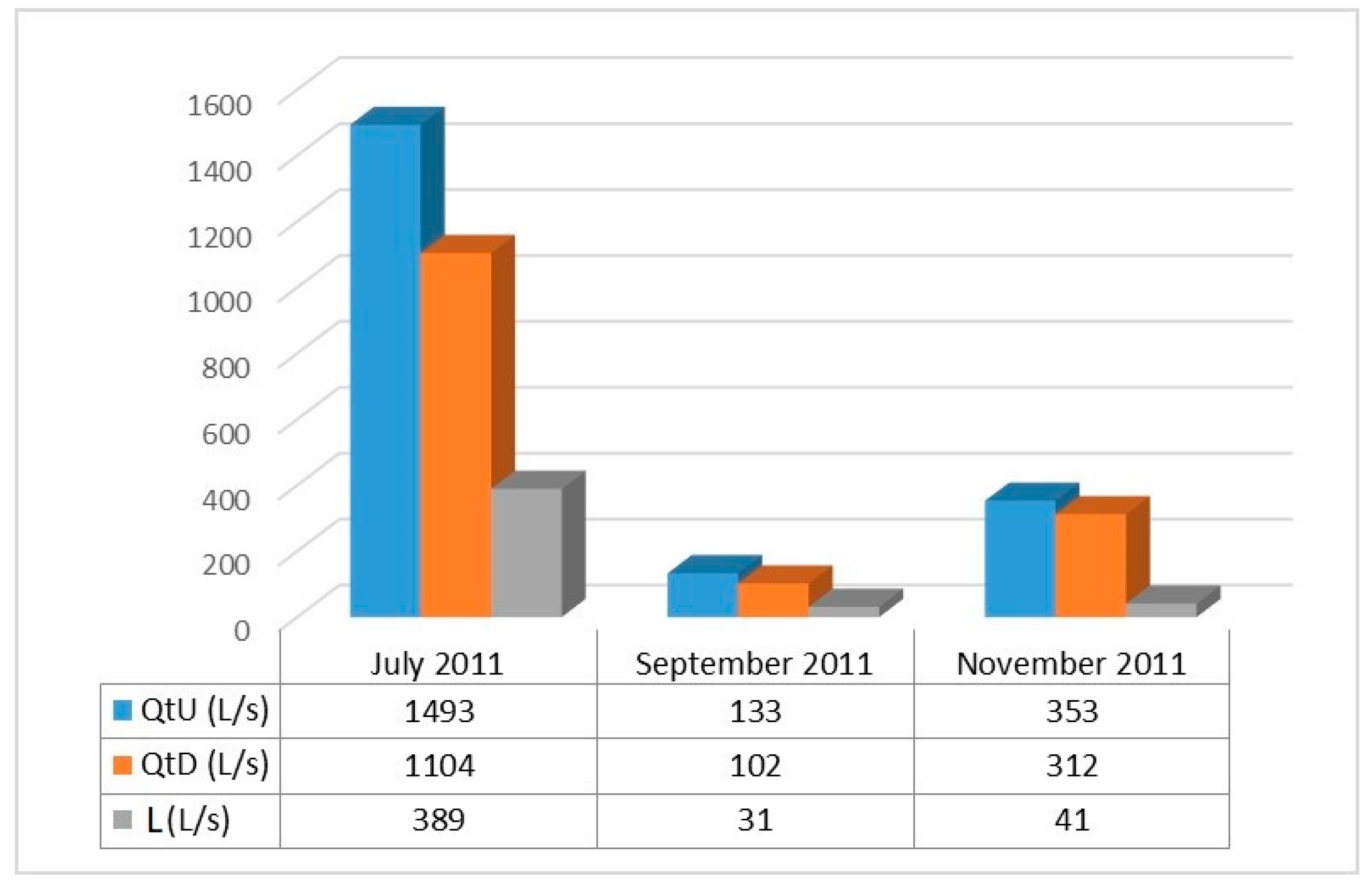
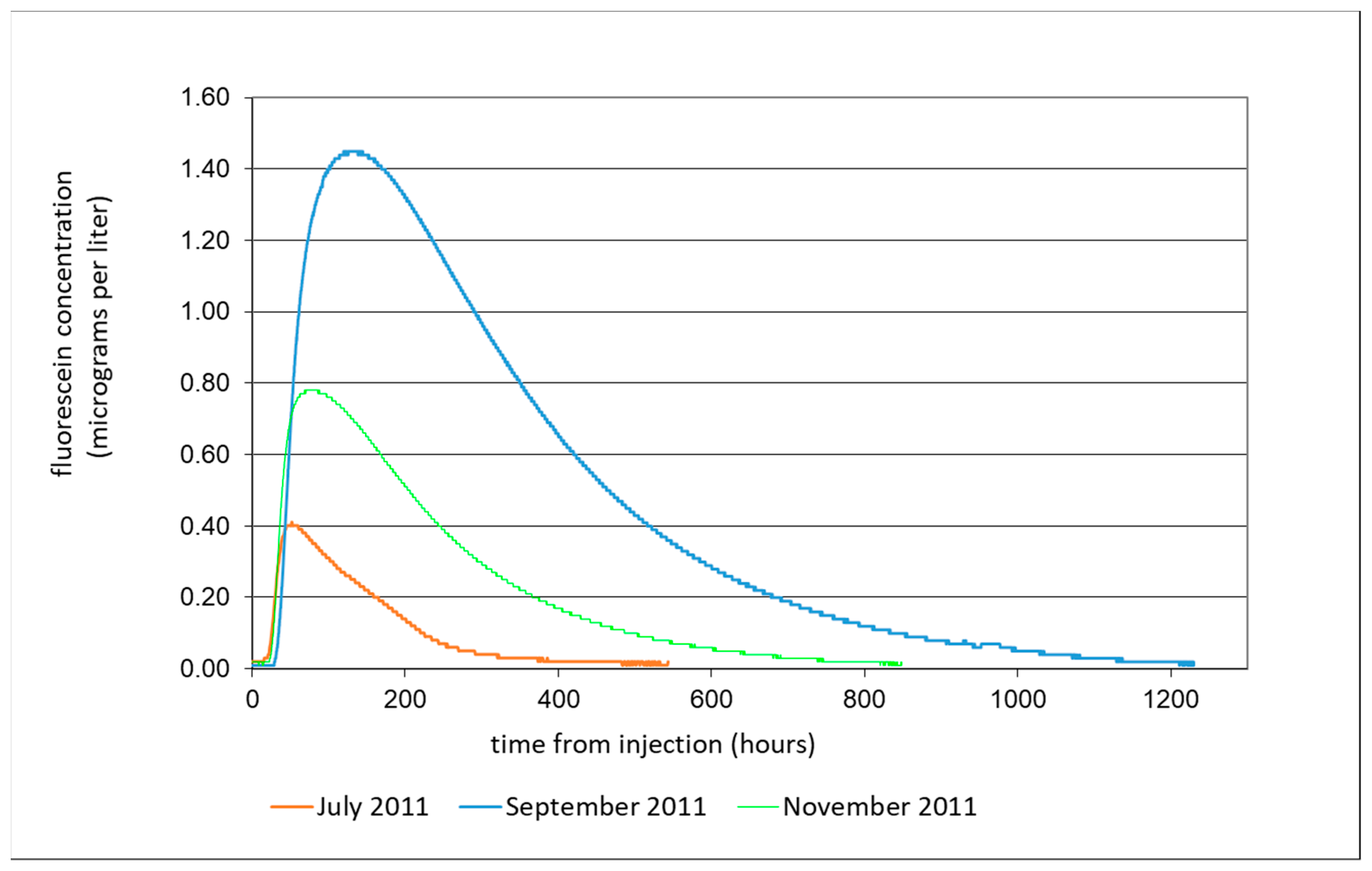
| Precipitation Station | Elevation (m) | Precipitation (mm/year) | Temperature (°C) |
|---|---|---|---|
| Borgofranco | 337 | 909 | 10.5 |
| Meugliano | 650 | 1422 | 8.3 |
| Pontboset | 775 | 1250 | 9.2 |
| Traversella | 1165 | 1610 | 7.6 |
| Sampling Campaign | Ca2+ | Mg2+ | Na+ | K+ | Cl− | SO42− | HCO3− | NO3− | Electrical Conductivity | pH | e% | |
|---|---|---|---|---|---|---|---|---|---|---|---|---|
| mg/l | mg/l | mg/l | mg/l | mg/l | mg/l | mg/l | mg/l | (µS/cm) | ||||
| MS | A | 15.09 | 3.14 | 1.51 | 1.11 | 0.73 | 11.11 | 52.48 | 2.96 | 105 | 7.4 | −2.4 |
| B | 17.78 | 2.56 | 1.64 | 1.09 | 0.82 | 13.48 | 54.92 | 3.42 | 116 | 8.5 | −2.5 | |
| C | 17.43 | 2.82 | 1.66 | 1.06 | 0.79 | 12.73 | 56.02 | 3.14 | 119 | 8.1 | −2.2 | |
| D | 16.26 | 2.72 | 1.28 | 0.78 | 0.64 | 11.72 | 49.91 | 3.19 | 108 | 8.3 | −0.9 | |
| E | 17.14 | 4.11 | 1.63 | 0.79 | 0.52 | 14.09 | 58.21 | 2.73 | 118 | 8.3 | −0.8 | |
| R1 | A | 8.34 | 2.97 | 1.16 | 0.50 | 0.48 | 4.93 | 33.44 | 2.85 | 69 | 7.5 | 0.9 |
| B | 13.88 | 1.72 | 1.35 | 0.45 | 0.64 | 6.33 | 43.93 | 3.66 | 90 | 7.6 | −1.3 | |
| C | 13.13 | 1.92 | 1.33 | 0.49 | 0.64 | 6.29 | 43.45 | 3.20 | 85 | 7.5 | −1.6 | |
| D | 9.23 | 0.48 | 0.79 | 0.44 | 0.42 | 4.13 | 25.14 | 3.34 | 57 | 7.4 | −1.6 | |
| E | 14.36 | 2.60 | 1.33 | 0.59 | 0.53 | 6.42 | 48.21 | 2.48 | 94 | 8.2 | 1.3 | |
| R2 | A | 6.73 | 4.05 | 1.15 | 10.82 | 9.05 | 4.63 | 33.44 | 3.07 | 84 | 7.5 | 2.4 |
| B | 12.60 | 2.01 | 1.36 | 0.49 | 0.73 | 5.74 | 40.64 | 3.48 | 85 | 7.7 | 0.2 | |
| C | 12.81 | 2.11 | 1.34 | 0.64 | 0.82 | 5.64 | 44.67 | 3.43 | 88 | 7.4 | 2.2 | |
| D | 9.28 | 1.04 | 0.74 | 0.49 | 0.42 | 4.14 | 29.90 | 3.14 | 57 | 7.4 | −3.6 | |
| E | 12.94 | 1.02 | 1.21 | 0.52 | 0.48 | 5.86 | 43.45 | 2.69 | 86 | 8.1 | −0.5 | |
| R3 | A | 8.02 | 3.24 | 0.99 | 0.55 | 0.46 | 4.89 | 36.00 | 2.73 | 69 | 7.5 | −1.7 |
| B | 12.23 | 2.34 | 1.04 | 0.38 | 0.41 | 5.38 | 41.37 | 3.32 | 80 | 7.6 | 0.2 | |
| C | 8.40 | 0.81 | 0.65 | 0.40 | 0.35 | 4.10 | 25.99 | 3.07 | 53 | 7.7 | −4.2 | |
| E | 11.77 | 1.78 | 1.00 | 0.43 | 0.31 | 5.56 | 42.71 | 2.34 | 75 | 8.2 | −4.5 |
| Location | Date/Time Period | Temperature (°C) |
|---|---|---|
| Renanchio Stream (altitude 450 m a.s.l.) ** | 16/03/2009 | 5.4 |
| Renanchio Stream (altitude 970 m a.s.l.) * | 14/07/2011 | 13.3 |
| Renanchio Stream (altitude 475 m a.s.l.) * | 14/07/2011 | 15.3 |
| Renanchio Stream (altitude 1475 m a.s.l.) ° | 18/10/2017 | 8.6 |
| Renanchio Stream (altitude 1013 m a.s.l.) ° | 03/10/2018 | 9.5 |
| Renanchio Stream (altitude 965 m a.s.l.) ° | 03/10/2018 | 9.5 |
| Montellina Spring ° | 25/01/2007–19/05/2007 | 10.0 |
| Montellina Spring ** | 16/03/2009 | 9.8 |
| Montellina Spring * | 27/09/2011–07/11/2011 | 8.9 |
| Montellina Spring ° | 18/10/2017 | 9.7 |
| Montellina Spring ° | 03/10/2018 | 9.6 |
| Parameter | (Mm3/y) |
|---|---|
| Precipitation | 34.2 |
| Evapotranspiration | 9.4 |
| Effective infiltration | 11.8 |
| Runoff | 13 |
| PARAMETER | TEST 1 | TEST 2 | TEST 3 |
|---|---|---|---|
| Qs = Montellina Spring discharge (L/s) | 181.0 | 144.0 | 171.0 |
| Mr = mass of fluorescein Mr which had reached the spring (g) | 38.086 | 281.827 | 123.806 |
| QtUs = Amount of water of low Renanchio Stream that feeds MS (L/s) | 14.4 | 18.7 | 14.8 |
| QtUs% = percentage of water of low Renanchio Stream that arrives to MS (%) | 0.97 | 14.1 | 4.2 |
| Qs% = percentage of MS discharge derived from low Renanchio Stream discharge (%) | 7.9 | 13.0 | 8.7 |
© 2019 by the authors. Licensee MDPI, Basel, Switzerland. This article is an open access article distributed under the terms and conditions of the Creative Commons Attribution (CC BY) license (http://creativecommons.org/licenses/by/4.0/).
Share and Cite
De Luca, D.A.; Cerino Abdin, E.; Forno, M.G.; Gattiglio, M.; Gianotti, F.; Lasagna, M. The Montellina Spring as an Example of Water Circulation in an Alpine DSGSD Context (NW Italy). Water 2019, 11, 700. https://doi.org/10.3390/w11040700
De Luca DA, Cerino Abdin E, Forno MG, Gattiglio M, Gianotti F, Lasagna M. The Montellina Spring as an Example of Water Circulation in an Alpine DSGSD Context (NW Italy). Water. 2019; 11(4):700. https://doi.org/10.3390/w11040700
Chicago/Turabian StyleDe Luca, Domenico Antonio, Elena Cerino Abdin, Maria Gabriella Forno, Marco Gattiglio, Franco Gianotti, and Manuela Lasagna. 2019. "The Montellina Spring as an Example of Water Circulation in an Alpine DSGSD Context (NW Italy)" Water 11, no. 4: 700. https://doi.org/10.3390/w11040700
APA StyleDe Luca, D. A., Cerino Abdin, E., Forno, M. G., Gattiglio, M., Gianotti, F., & Lasagna, M. (2019). The Montellina Spring as an Example of Water Circulation in an Alpine DSGSD Context (NW Italy). Water, 11(4), 700. https://doi.org/10.3390/w11040700






